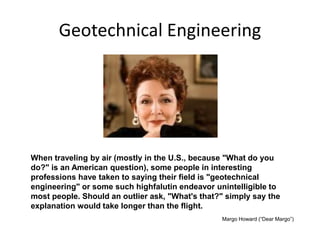Some Ideas on Geotheta You Should Know
Table of ContentsThe 8-Minute Rule for GeothetaThe Best Strategy To Use For GeothetaGeotheta Things To Know Before You Get ThisThe Single Strategy To Use For GeothetaWhat Does Geotheta Mean?

They carry out website examinations, accumulate samples, perform lab examinations, and assess information to review the suitability of the ground for construction tasks - Tailings Engineer. Based on their searchings for, geotechnical engineers supply suggestions for foundation style, slope security, retaining frameworks, and mitigation of geotechnical dangers. They team up with various other specialists, such as architects, architectural engineers, and building and construction groups, to make sure that geotechnical factors to consider are integrated into the overall project design and execution
By examining the behavior and buildings of soil and rock, they can recognize possible geotechnical hazards such as landslides, dirt negotiation, or incline instability. Their knowledge helps stop failings or accidents that can threaten lives and home. Below are some thorough duties and obligations of a geotechnical engineer: Site Examination: Geotechnical designers conduct website investigations to gather information on subsurface conditions.
They analyze the data to recognize the residential or commercial properties and behavior of the dirt and rock, including their toughness, leaks in the structure, compaction features, and groundwater problems. Geotechnical Evaluation and Style: Geotechnical engineers examine the data collected throughout website examinations to examine the stability and suitability of the site for building projects. They do geotechnical calculations and modeling to evaluate factors such as bearing capacity, settlement, incline stability, side earth pressures, and groundwater circulation.
The Best Strategy To Use For Geotheta
Structure Style: Geotechnical engineers play an important duty in creating structures that can safely support the desired structure. They analyze the dirt conditions and load demands to identify the proper foundation type, such as superficial foundations (e.g., footings), deep structures (e.g (https://yoomark.com/content/httpsgeothetacom)., heaps), or specialized techniques like soil renovation. They take into consideration variables such as negotiation limits, birthing capacity, and soil-structure interaction to create ideal structure layouts
They assess construction plans, screen website activities, and conduct area evaluations to validate that the layout referrals are followed. If unanticipated geotechnical issues arise, they assess the scenario and give suggestions for remediation or modifications to the design. Risk Evaluation and Reduction: Geotechnical engineers examine geotechnical hazards and risks related to the task site, such as landslides, liquefaction, or soil disintegration.

Cooperation and Communication: Geotechnical engineers work closely with various other professionals associated with a project, such as designers, architectural designers, and building teams. Reliable interaction and partnership are essential to incorporate geotechnical factors to consider right into the overall task style and construction process. Geotechnical designers offer technological know-how, response queries, and make certain that geotechnical requirements are fulfilled.
Geotheta Can Be Fun For Everyone
Below are some types of geotechnical designers: Foundation Engineer: Foundation engineers focus on making and assessing structures for structures. They assess the soil conditions, tons requirements, and site attributes to establish the most appropriate foundation kind and style, such as shallow structures, deep structures, or specialized techniques like pile foundations.
They review the elements affecting incline stability, such as dirt homes, groundwater problems, and slope geometry, and establish methods to avoid incline failures and mitigate dangers. Quake Designer: Quake engineers focus on evaluating and creating structures to withstand seismic forces. They examine the seismic danger of a site, review dirt liquefaction capacity, and establish seismic style requirements to ensure the safety and durability of structures throughout quakes.
They do field testing, collect go now samples, and analyze the accumulated data to identify the soil properties, geologic formations, and groundwater problems at a site. Geotechnical Instrumentation Designer: Geotechnical instrumentation engineers concentrate on monitoring and measuring the behavior of soil, rock, and frameworks. They install and keep instrumentation systems that keep an eye on variables such as soil settlement, groundwater degrees, incline motions, and structural variations to examine efficiency and provide very early warnings of possible issues.
Geotheta Can Be Fun For Everyone
They conduct tests such as triaxial tests, combination examinations, straight shear examinations, and leaks in the structure examinations to gather information for geotechnical evaluation and layout. Geosynthetics Designer: Geosynthetics engineers specialize in the layout and application of geosynthetic materials, such as geotextiles, geogrids, and geomembranes. They make use of these materials to boost dirt stability, reinforce slopes, offer water drainage remedies, and control erosion.
They tend to be investigatory individuals, which implies they're intellectual, introspective, and analytical. They are interested, systematic, rational, analytical, and logical. Some of them are additionally social, indicating they're kind, charitable, cooperative, patient, caring, useful, empathetic, skillful, and pleasant - Engineer of Record.
In the workplace setting, geotechnical designers make use of specialized software application devices to perform computations, develop styles, and evaluate information. They prepare records, review task specifications, interact with clients and staff member, and coordinate project tasks. The workplace setting supplies a favorable atmosphere for research, evaluation, and collaboration with other specialists involved in the job.
Geotheta for Beginners
They regularly go to task sites to perform website investigations, evaluate geotechnical problems, and collect information for evaluation. These sees entail traveling to different areas, in some cases in remote or challenging terrains. Geotechnical designers may do soil sampling, conduct examinations, and screen building tasks to ensure that the geotechnical aspects of the job are being implemented properly.
Geotechnical engineers also work in specialized geotechnical research laboratories. In these facilities, they conduct experiments, do tests on soil and rock examples, and evaluate the engineering homes of the materials. Geotechnical research laboratory engineers work thoroughly in these environments, managing testing devices, running tools, and recording data. They team up with various other research laboratory staff to make sure exact and dependable testing outcomes.